32 Michelangelo Paintings & Works That Still Inspire in 2025
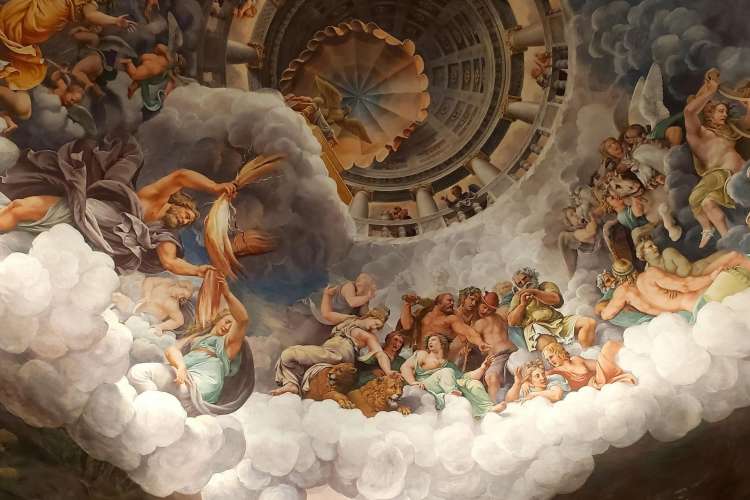
You’ve probably seen Michelangelo paintings before — even if you didn’t realize it. His Creation of Adam, where God reaches out to touch Adam’s hand, has been reimagined everywhere from ceiling murals to coffee mugs. It’s just one part of the legendary Sistine Chapel ceiling in Vatican City, and one of the most iconic works by one of the most famous painters in history.
Interest in Michelangelo’s work isn’t slowing down either. From blockbuster museum exhibitions to high-tech replicas like the touring Sistine Chapel: The Exhibition, his art continues to draw massive crowds and inspire new generations. You’ll find vivid Biblical frescoes, striking panel paintings and soaring marble sculptures, many of them still exactly where they were first installed centuries ago.
Want to know what makes these works so unforgettable? Here’s a look at the Michelangelo paintings and sculptures that continue to inspire and where you can see them today.
Jump to Section
- Who is Michelangelo?
- What is Michelangelo Best Known For?
- How Many Sculptures & Paintings Did Michelangelo Make?
- How Did Michelangelo Die?
- Michelangelo’s Most Famous Paintings
- Top Michelangelo Paintings: Sistine Chapel Ceiling
- Michelangelo's Other Religious Frescoes
- Michelangelo’s Most Famous Sculptures
Who is Michelangelo?

One of the most well-known artists of the Italian Renaissance, Michelangelo Buonarroti, was born in Florence in 1475. He was a painter, sculptor and architect with a reputation for being nothing short of a genius. He worked across nearly every creative medium, often blurring the line between artist and engineer.
Michelangelo paintings usually focused on Biblical stories and were often commissioned by the Catholic Church. Some are larger-than-life frescoes, like the ones across the Sistine Chapel ceiling. Others are smaller works now found in museums. And of course, not everything he made was painted. You’ve probably heard of David — that towering 17-foot marble statue is his too.
What is Michelangelo Best Known For?
Michelangelo, sometimes known as “Il Divino” or “The Divine One,” is remembered not just for his talent but for how much his work shaped the course of art history. Like his older contemporary Leonardo da Vinci, he created some of the most famous works of art from the period, including beautiful frescoes and soaring architectural designs found in some of the most renowned landmarks and churches across Europe. His approach to composition and form can still be felt in later works, including many Caravaggio paintings, which make use of Michelangelo’s painting techniques.
How Many Sculptures & Paintings Did Michelangelo Make?
Michelangelo is credited with around 200 finished and unfinished works across painting, sculpture and architecture, some dating back to when he was just 13. His commissions came from powerful patrons, including the Catholic Church, Italian aristocrats and the influential Medici family, known for supporting some of the greatest Renaissance art and architecture. Many of his most famous Renaissance paintings are part of the massive Sistine Chapel ceiling in Rome, still considered one of the most ambitious projects in Western art. In his later years, he also wrote poetry, with over 300 known works to his name.
His life and creative process were unusually well documented for the time. Two biographies were written before he died — one by Giorgio Vasari and another by Ascanio Condivi — and hundreds of letters between Michelangelo and his family still exist.
Original Michelangelo paintings are rare, with most held by museums across Europe, but those that do surface have been valued in the tens of millions. Others exist only as copies or reproductions created by artists of his time.
How Did Michelangelo Die?
Michelangelo died in 1564 at the age of 88, after a brief illness. He continued writing and working almost until the end, leaving behind several unfinished pieces. His long life, especially for the era, gave him the chance to shape not just a period, but an entire legacy. He is buried in the Basilica di Santa Croce in Florence, among other giants of Italian history.
Michelangelo’s Most Famous Paintings & Drawings
1. Doni Tondo (1506)

This unique round panel painting of the Holy Family was commissioned by Florentine merchant Agnolo Doni to mark the birth of his child. “Tondo” refers to the circular shape, which was a popular format for private devotional art at the time.
While round panels weren’t typical for Michelangelo paintings, this one shows off his creative range and command of composition. The Doni Tondo is on display at the Uffizi Gallery in Florence.
2. The Entombment (1501)

Believed to be unfinished because Michelangelo left Rome to return to Florence and work on David, this oil panel depicts Christ’s body being lowered into the tomb. For years, its authorship was uncertain, but scholars now widely attribute it to Michelangelo based on letters and stylistic details. The panel is on display and currently owned by the National Gallery in London.
3. Battle of Cascina (1504)

Commissioned by Piero Soderini for the Palazzo Vecchio, this painting was never completed. It was intended for a wall in the Palazzo to be shown among other Renaissance battle works, similar to the famed Leonardo da Vinci paintings and Raphael Paintings.
Although never completed, Michelangelo created a detailed sketch for the composition, which was widely copied by his students before the original was lost. The chaotic battle scene shows Florentine soldiers ambushed by Pisans while bathing in the Arno. Surviving copies and studies are part of collections at the Uffizi Gallery and the British Museum.
4. Leda and the Swan (1530)

This is one of the Michelangelo paintings that moves away from biblical references and toward mythology. It's based on the famous Greek myth of Zeus’s seduction of a young maiden by taking on the form of a swan and was created in tempera on canvas. It was commissioned by the Duke of Ferrara while Michelangelo was still working on the Sistine Chapel.
Although the original from 1530 was lost, copies attributed to Michelangelo’s students survive in collections such as the National Gallery in London, the Gemäldegalerie in Berlin and Casa Buonarroti in Florence.
5. Manchester Madonna (c. 1497)

This panel shows the Virgin Mary with Christ and a young John the Baptist, with partially completed figures on one side revealing Michelangelo’s process. Believed to have been painted in Rome, it was only later attributed to Michelangelo. The Manchester Madonna remains in the permanent collection of The National Gallery.
Top Michelangelo Paintings: Sistine Chapel Ceiling
6. Sistine Chapel Ceiling (1512)

It’s easily one of the most famous Michelangelo paintings — though technically, it’s a whole series of scenes across the Sistine Chapel ceiling in Vatican City. The panels tell stories from the Old Testament, featuring the apostles and other notable Christian figures like God, Adam, Eve and Noah.
Michelangelo was commissioned by the Catholic Church to paint over a starry blue ceiling, and what followed was four years of intense, detailed work that completely transformed the space.
If you can’t make it to Rome, don’t worry — when on tour, high‑definition, life‑size exhibitions like Michelangelo’s Sistine Chapel: The Exhibition (recently in NYC’s Industry City) offer a powerful, up‑close look. Plus, Fordham University in the Bronx now houses a quarter‑scale Met‑made reproduction in Butler Commons at Rose Hill. It's a great hidden gem in NYC if you’re local
7. Sistine Chapel Ceiling: The Creation of Adam (1512)

Perhaps the most famous panel of the Sistine Chapel’s immense ceiling, this painting features the moment the reclining Adam is granted life through the touch of God. It’s one of the most recognized Michelangelo paintings and has been endlessly referenced and parodied across pop culture. It is the central panel of the ceiling of the chapel located inside the Vatican Museum.
8. Sistine Chapel Ceiling: Creation of Eve (1511)

Like the other Michelangelo paintings on the Sistine Chapel ceiling, Creation of Eve tells a biblical story. It’s the fifth panel in the creation sequence and is positioned just before Creation of Adam, showing a newly formed Eve, hands clasped in prayer, as she emerges from Adam's side.
9. Sistine Chapel Ceiling: Delphic Sibyl (1509)
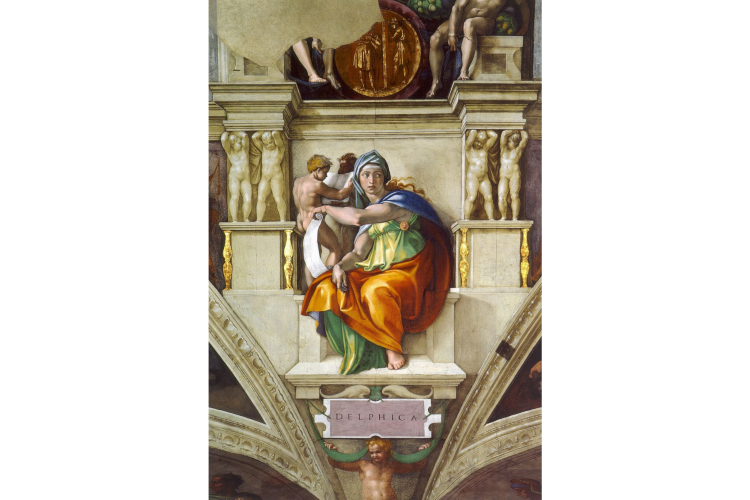
This is one of the most colorful and expressive figures on the Sistine Chapel ceiling and also Michelangelo paintings in general. The Delphic Sibyl, an ancient Greek prophetess, is seated and holding a scroll with her name, “Delphica,” written below. A cherub reads behind her as she looks on, blending mythology and biblical vision.
10. Sistine Chapel Ceiling: Drunkenness of Noah (1509)

Another one of the famous Michelangelo paintings from the ceiling of the Sistine Chapel, this panel tells the story of Noah after the flood. After tilling the land and growing grapes, he becomes drunk and is exposed by a vat. His sons surround him, some mocking, others covering him. It’s a moment that reflects both shame and grace, showing humanity’s flaws and potential.
11. Sistine Chapel Ceiling: The Deluge (1512)

This scene depicts the Great Flood, with Noah’s ark in the distance and people scrambling on the banks to escape rising waters. It’s the eighth scene of Noah’s story and is one of the most populated and emotionally intense Michelangelo paintings on the ceiling, capturing the chaos and desperation of the moment.
12. Sistine Chapel Ceiling: The Sacrifice of Noah (1512)

The seventh scene in the Genesis series, this panel shows Noah and his wife preparing a ram for sacrifice during a celebration. Surrounding the main scene are nude figures holding large symbolic medallions, typical of Michelangelo’s use of allegorical framing.
13. Sistine Chapel Ceiling: Prophet Isaiah (1512)

One of seven prophets painted on the Sistine Chapel ceiling, this figure sits near the High Altar. Isaiah is dressed in flowing, colorful robes and holds a blue book, while two cherubs peek over his shoulder, who appear to be communicating with the famous biblical character.
14. Sistine Chapel Ceiling: The Prophet Zechariah (1512)

This smaller panel shows the Prophet Zechariah reading from a book in a colorful robe with two cherubs poised over his shoulder. This panel was created during the four years that the artist was working on the ceiling. Being part of the larger group of Michelangelo paintings, it adds depth and gravity to the prophetic sequence along the ceiling’s edges.
15. Sistine Chapel Ceiling: The Prophet Ezekiel (1511)
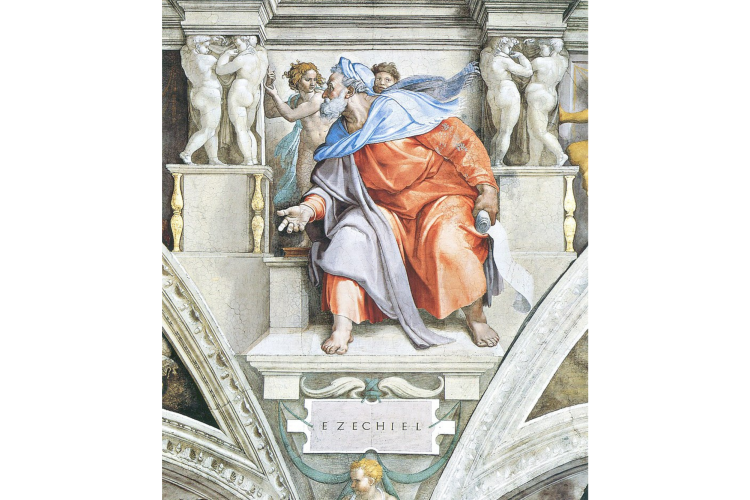
Ezekiel engages with the surrounding panels (CC0)
Painted earlier in the ceiling’s sequence, Ezekiel appears as a powerful, elderly figure holding a scroll and gesturing outward. Youthful attendants around him point toward surrounding scenes, including the Creation of Eve and the Fall of Man.
16. Sistine Chapel Ceiling: Libyan Sibyl (1512)

This Sibyl appears near the main altar wall, holding a large book and looking downward. Her muscular pose and vibrant drapery make her one of the standout figures among the Sybils. It was one of the final Michelangelo paintings added to the famous ceiling. She appears adjacent to the Old Testament scene of God Dividing Light from Darkness.
A preparatory sketch of the Libyan Sibyl by Michelangelo is held by the Metropolitan Museum of Art, offering insight into his early vision for the panel.
Michelangelo's Other Religious Frescoes
17. The Crucifixion of Saint Peter (1550)

One of the lesser-known Michelangelo paintings, this Roman fresco is located in the Cappella Paolina, just steps from the Sistine Chapel. It's one of Michelangelo’s darker works, which shows Saint Peter at the moment before his crucifixion — upside down, as tradition says he requested. The downward tilt of the cross and the raw tension in the scene create a dramatic moment that feels almost cinematic. Commissioned in 1541 by the Catholic Church, it remains a powerful if often overlooked part of his legacy.
18. The Last Judgment (1535–1541)

This monumental scene of the Second Coming of Christ spans the entire altar wall of the Sistine Chapel. Painted more than 20 years after Michelangelo finished the ceiling, The Last Judgment shows souls rising and falling as Christ delivers the final judgment. The figures are energetic, almost chaotic, yet everything leads the eye back to Christ at the center. Commissioned by Pope Clement VII, it took over four years to complete and remains one of Michelangelo’s boldest and most debated works.
Of all the Michelangelo paintings in the Sistine Chapel, this altar wall fresco is the most visually overwhelming.
19. The Torment of Saint Anthony (1487 – 1488)

Michelangelo painted this copy of a famous engraving by Martin Schongauer at the age of only 12, though the painting's provenance is often questioned. It depicts a scene chronicled in “The Temptation of St. Anthony” where Saint Anthony is fighting off demons after resisting their temptations, held aloft over a distant landscape. It’s currently on display in the Kimbell Art Museum in Texas.
20. Madonna and Child with Saint John and Angels (1497)

This tempera painting, often called the "Manchester Madonna," is an unfinished rendering of the Madonna and Child that is on display in London’s National Gallery. While attribution to Michelangelo was often in dispute over the past two centuries, most experts agree that it is Michelangelo's work. The Madonna is depicted with one breast bared, possibly in reference to her role as a breastfeeding mother.
21. The Fall of Phaëthon (1533)

Not a painting, but rather a charcoal drawing, this classical myth figure often appears in paintings, but this rendering by Michelangelo is perhaps one of the most well-known. Located at the British Museum in London, it shows Ovid’s tale of the young man whose chariot was cast down from the sky with a thunderbolt as his horses fell, still yoked together, over a crowd of onlookers.
22. Epifania (1550-53)

Created in black chalk on paper, this rendering is actually made up of multiple sheets of paper, standing over seven feet tall in total in its display at the British Museum in London. It depicts Mary with Christ playing on the floor in front of her, flanked by John the Baptist and Saint Joseph.
23. Pietà for Vittoria Colonna (1538-44)

Owned by the Gardner Museum in Boston, this rendering of a distraught Mary was created in black chalk on cardboard. It was created for Vittoria Colonna, a famous Italian noblewoman, who invited Michelangelo into her social circle and for whom he did several drawings and paintings.
Michelangelo’s Most Famous Sculptures
24. David (1501-1504)

One of Michelangelo’s most famous works, this 17-foot-tall statue of David was carved from a single block of white Carrara marble. Originally commissioned for the exterior of Florence’s cathedral, it instead became a symbol of the city and stood in the Piazza della Signoria for centuries.
Today, the original is housed in the Galleria dell'Accademia in Florence, while a replica stands in its original public spot. Michelangelo took over the project after other sculptors had abandoned the flawed slab and turned it into one of the greatest sculptures ever created.
While it's clearly not one of the famous Michelangelo paintings, it’s made just as much of an impact. Full-scale replicas can be found all over the world, including a bronze version at Piazzale Michelangelo and a plaster cast at the Palazzo Vecchio, both in Florence. You’ll also find official copies in London’s Victoria & Albert Museum, Copenhagen, Moscow and Brussels.
In the U.S., David makes appearances in some unexpected places. You can find full-size versions at Caesars Palace in Las Vegas, Forest Lawn Memorial Park in Glendale, California, and Delaware Park in Buffalo, New York. There’s a bronze replica at the Ringling Museum in Sarasota, and a damaged teaching cast at California State University, Fullerton. A gold-painted, double-sized foam version even stands outside the 21c Museum Hotel in Louisville, Kentucky — a reminder that Michelangelo’s David remains one of the most recognizable sculptures in the world. If you're feeling inspired to get creative while visiting the statue, check out a lively paint and sip class in Louisville. Glass in hand, you'll mingle with fellow creatives as a professional artist walks you through every brushstroke, turning blank canvases into personal masterpieces while the wine (or whiskey) flows.
25. Pieta (1500)

An early masterpiece showing Mary holding the body of Christ (Stanislav Traykov; CC BY 2.5)
Commissioned by a Roman cardinal in 1494, Michelangelo began this sculpture in his early 20s and completed it a few years later for a side chapel in the Old St. Peter’s Basilica in Rome. The Pietà shows the Virgin Mary gently holding Christ after the crucifixion, her face calm and composed in a moment of immense sorrow. It was a groundbreaking piece at the time, not only for its emotional realism, but also because it was one of the first major sculptures in Christian art to feature more than one figure.
Today, the original Pietà is on display behind protective glass inside St. Peter’s Basilica in Vatican City, where millions of visitors see it each year. Its reputation as a masterpiece of composition and carving has led to several exact replicas being commissioned around the world.
In the United States, you can view full-scale reproductions in the Cathedral Basilica of Saint Louis, St. John the Baptist Catholic Church in Costa Mesa, California, and other cathedrals and shrines. These officially authorized versions are often placed in spaces meant for quiet reflection, echoing the emotional power of the original.
26. The Moses (1545)

Commissioned in 1505 by Pope Julius II for his own burial tomb, this large sculpture depicts the figure of Moses seated, holding the tablets of the Ten Commandments, with a long flowing beard and two small horns atop his head. The horns aren’t a mistake, they come from a mistranslation of the Hebrew word for “radiant” in the Latin Vulgate Bible. Michelangelo’s Moses isn’t just wise; he’s glorified, charged with divine energy, and carved with intense physicality. Today, most scholars translate this as "glorified" according to Christ and Pop Culture.
Michelangelo began work on the tomb shortly after the pope’s death in 1513, but the project was scaled back multiple times. Moses was originally meant to be one of many large figures, but eventually became the centerpiece of the tomb’s final version. The sculpture was completed around 1545 and is now housed in San Pietro in Vincoli, a church in Rome, separate from Julius II’s actual burial site in the Vatican.
27. Santo Spirito Crucifix (1541)
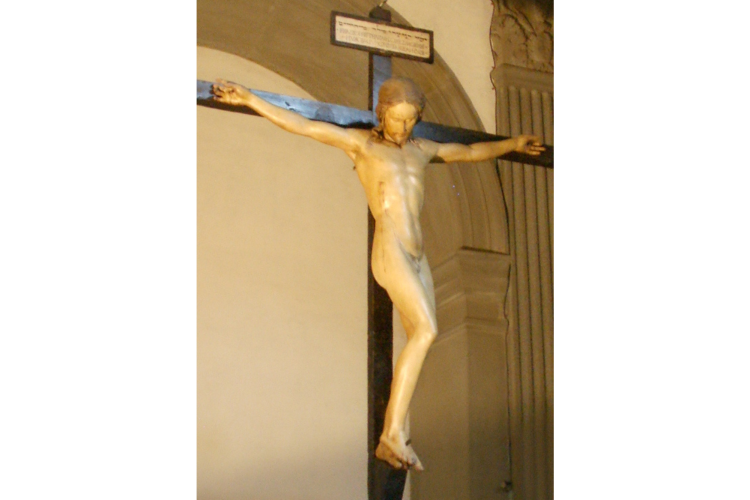
Created from polychrome wood when Michelangelo was still in his youth, this is actually one of two crucifix sculptures he created. It was believed lost until the 1960s. It was created for the high altar in the Church of Santo Spirito di Firenze in Florence. It is owned by the British Museum.
28. Madonna of Bruges (1504)

A depiction of the Virgin and child in marble, this sculpture stands six feet tall and was crafted from a single slab of marble. It is known for its unusual rendering of Mary's gaze away from the child she holds and toward the viewer. It was created for an altar in the Church of Our Lady, Bruges, where it remains today.
29. Bacchus (1497)

One of Michelangelo's first large-scale sculptures, this classical world-inspired sculpture depicts an oversized God of Wine. It was commissioned by a cardinal and collector, who later rejected it, leaving it to be acquired by Michelangelo's friend, Jacopo Galli. It is one of Michelangelo's few sculptural works not based on Christian mythology.
30. Dying Slave (1513)
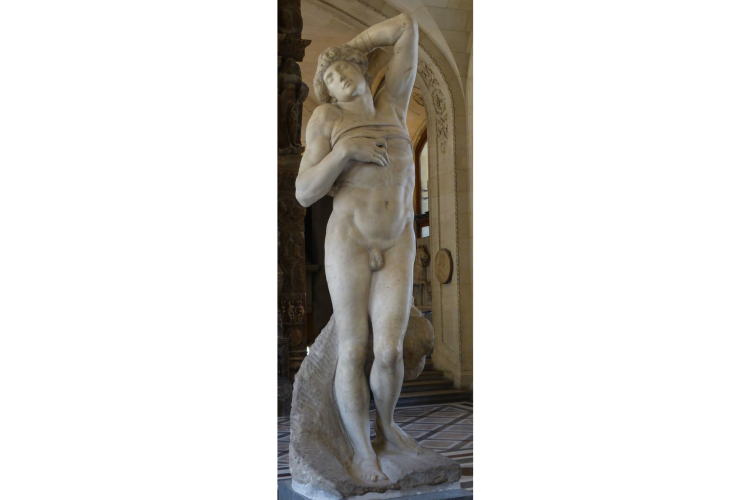
This was one of two sculptures commissioned to flank Pope Julius' tomb, this one being commissioned by the pope himself. He canceled the commission before Michelangelo could complete the second one, “The Rebellious Slave." The figure is shown upright with arms extended in the last moments of life. It is owned by the Louvre Museum in Paris.
31. Madonna of the Stairs (1490)
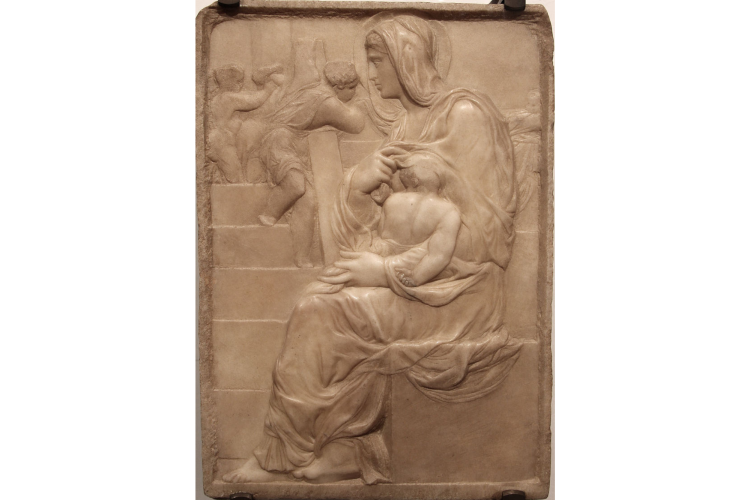
This relief sculpture featuring Mary holding her son while surrounded by cherubs is housed in the Casa Buonarroti in Florence. Sculpted when the artist was only 15, it’s considered one of his very first works in sculpture, along with another relief sculpture, Battle of the Centaurs, believed to have been created the same year.
32. Leah (1542–1545)

Depicting a figure from the Old Testament, this statue was created as part of Pope Julius II’s tomb decoration along with several other figures housed in the San Pietro in Vincoli. It is accompanied by another biblical figure, Rachel, in niches around the burial tomb.
One of the preeminent artists of both the High Renaissance and Western art, many Michelangelo paintings show innovation that influenced countless artists both in his time and in the centuries afterward. His work may even inspire you as an artist to explore new mediums and techniques, as well as a “Renaissance Man” (or shall we say "Renaissance Person") approach to creativity.
Michelangelo didn’t just shape the High Renaissance — he redefined what it meant to be an artist. From frescoes to sculpture, many Michelangelo paintings still stop people in their tracks. Even today, standing beneath the Sistine Chapel ceiling or in front of David, it’s hard not to feel something shift. Maybe it sparks an idea, a new way of seeing, or just a sense of awe. However it hits you, Michelangelo paintings remain a reminder that creativity doesn’t have to stay in one lane. Maybe it’s time to channel a little “Renaissance Person” energy of your own.
For even more painting ideas, check out other experiences happening on Classpop!

